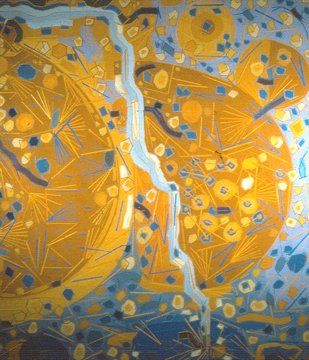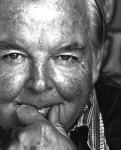
Lee Mullican
American, 1919 -1998
California Poster, 1969
acrylic on canvas
50 1/2 x 40 1/2 in.
SBMA, Gift of the artist to the Ala Story collection
1971.20

Undated photo of Lee Mullican
Lee Mullican produces "landscapes of the mind ... where anything can happen"
COMMENTS
The Life of Lee Mullican
Lee Mullican was born December 2, 1919, in Chickasha, Oklahoma. He developed an interest in art when he spent two years at the Universities of Texas and Oklahoma. In 1941, he went to Kansas City Art Institute, graduating in 1942. He served in the Army Corps of Engineers as a topographic draftsman where he took aerial photographs and drew maps of the California desert, the south Pacific and Japan. This experience played a seminal force in his paintings.
World War II had a great effect on his work and during the year of 1946 he spent a year drawing in New Mexico. In the 1950's, Mullican's work began to reflect upon American Indian Culture which was influenced by his home of orgin in the Southwest and his-visit to New Mexico. These experiences provoked atmosphere, light and space in his paintings.
In 1947, Mullican moved to San Francisco where he met Surrealists Gordon onslow-Ford and Wolfgang Paalen and their wives Jaqueline Johnson and Luchita Hurtado. The group created what they called Dynaton. The purpose of the group was to touch upon their subconcious spirits in the mediatative sense. Thus, their paintings had a "spiritual aura", a calmness about them.
Mullican had his first solo show at the San Francisco Museum of Art and two years later the Dynaton group presented their work as well.
He had many shows, including one at the Paul Kantor Gallery in Southern California and later entered numerous group exhibitions that traveled throughout the country.
In 1960, Mullican received a Guggenheim Fellowship where he was able to travel to Rome, meeting Rico Lebrun. After a year, he returned to Los Angeles teaching summer school courses at the University of Southern California and eventually is employed at the University of California, Los Angeles.
His work looks to the Symbolists and the early Expressionists painters like Jackson Pollack and Mark Tobey. He practices Zen meditation and studies Oriental philosophy which he feels inhances new concepts of reality. In his later work, these concepts become a seminal force in his work.
Information found in the SBMA docent files.
No bibliography, date or author.
